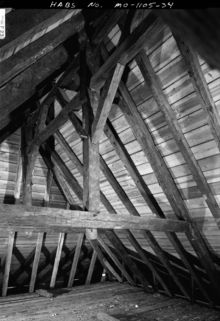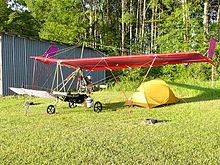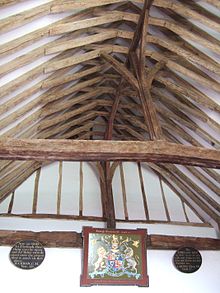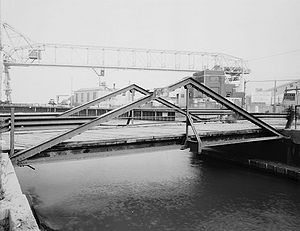- King post
-
Crown posts in the nave roof at Old Romney church, Kent, England

 A so-called "Norman truss" in the 18th-century Bolduc House in Ste. Geneviève, Missouri
A so-called "Norman truss" in the 18th-century Bolduc House in Ste. Geneviève, Missouri
A king post (or king-post) is a central vertical supporting post used in architectural, bridge, or aircraft design applications.
Contents
Architecture
A king post (or crown post) extends vertically from a crossbeam to the apex of a triangular truss.[1] The king post connects the apex of the truss with its base, holding up the tie beam at the base of the truss. King posts were used in roof construction in Medieval architecture in buildings such as parish churches and tithe barns, and also appear in Gothic Revival architecture and Queen Anne architecture. A similar structure may be used to construct a simple bridge.
A development of the king post structure terminates the central post before it reaches the apex of the roof truss. Instead, the king post is held in place by a collar beam, a secondary beam parallel to the tie beam. In this structure, the central post is termed the crown post.
An alternative truss construction uses two queen posts (or queen-posts). These vertical posts, positioned along the base of the truss, are supported by the sloping sides of the truss, rather than reaching its apex. A development adds a collar beam above the queen posts, which are then termed queen struts. A section of the tie beam between the queen posts may be removed to create a hammerbeam roof.
Norman truss
Architectural historians in Louisiana use the term "Norman roof" to refer to a steeply-pitched roof; it is supported by what they call a "Norman truss". This is a through-purlin truss consisting of a tie beam and paired truss blades, with a central king post to support the roof ridge. The name derives from a belief that this system of construction was introduced to North America by settlers from Normandy in northern France, but it is really a misnomer as the system was more widely used than that.[2]
King post truss
The king post truss is used for simple roof trusses and short-span bridges. It is the simplest form of truss in that it is constructed of the fewest number of truss members (individual lengths of wood or metal). The truss consists of two diagonal members that meet at the apex of the truss, one horizontal beam that serves to tie the bottom end of the diagonals together, and the king post which connects the apex to the horizontal beam below. For a roof truss, the diagonal members are called rafters, and the horizontal member may serve as a ceiling joist. A bridge would require two king post trusses with the driving surface between them. A roof usually uses many side-by-side trusses depending on the size of the structure.[3]
Marine Engineering
On a cargo ship a king post is an upright with cargo-handling devices attached to it. Since king posts are designed for handling cargo, they are located at the forward or after end of a hatch.[4]
Aviation
 DFE Ascender III-C ultralight aircraft showing its king post above the wing.
DFE Ascender III-C ultralight aircraft showing its king post above the wing.
King posts are also used in the construction of wire-braced aircraft, where the king post supports the top cables or "ground wires" supporting the wing.
See also
- Timber roof trusses Traditionally constructed timber trusses.
References
- ^ Tredgold, Thomas. Elementary Principles of Carpentry. Philadelphia: E.L. Carey and A. Hart. pp. p94. http://books.google.com/books?id=fDJVAAAAMAAJ. Retrieved 2008-08-01.
- ^ Edwards, Jay Dearborn; Kariouk (Pecquet du Bellay de Verton), Nicolas (in English, French, Creole, Spanish). A Creole Lexicon. Baton Rouge: LSU Press. pp. 142. ISBN 0807127647. http://books.google.co.uk/books?id=EY5E5bp9KGwC&pg. Retrieved 2008-10-23.
- ^ Wood, De Volson (1883). "II". Treatise on the Theory of the Construction of Bridges and Roofs. New York: J. Wiley & Sons. pp. p43. http://books.google.com/books?id=SZYPAAAAYAAJ.
- ^ Global Security (undated). "CHAPTER 13 AIRCRAFT AND SHIP IDENTIFICATION". http://www.globalsecurity.org/military/library/policy/navy/nrtc/14243_ch13.pdf. Retrieved 2008-11-05.
External links
- Bridge Basics
- Timber roofs
- Crown post roofs
- King and Queen post roofs on the former mansion at Parlington, nr Aberford in Yorkshire, England
- An Illustrated glossary of roofs and roofing terms.
Categories:- Architectural elements
- Structural engineering
- Architectural element stubs
Wikimedia Foundation. 2010.



